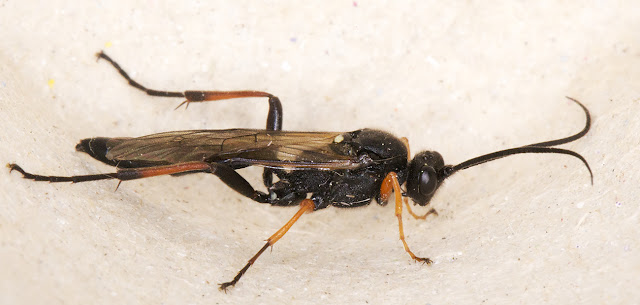 |
| Hornet, Vespa crabro. West Wickham Common light trap, 11 September 2015 |
Now for some wasps found in my moth traps in 2015. The first photo is a magnificent hornet, all honey tones and aggressive stance. Look at those mandibles! I think that's a moth wing scale sticking to one of them. Luckily, it was not very lively first thing in the morning.
 |
| Common Wasp, Vespula vulgaris. Hayes light trap, 11 August 2015. |
If you compare it with this common wasp, you can see that this has the same basic body plan, but differs in coloration and patterning. The common wasp is also much smaller, but can turn up in the trap in large groups.
 |
| Ichneumon wasp, Ophion luteus. West Wickham Common light trap, 11 September 2015. |
Ichneumon wasps look quite different. They are parasitic, laying their eggs usually in the larvae of other insects. There are 1200 species of ichneumons in the UK alone, of various sizes and colours. This one is quite large.
 |
| Male ichneumon wasp. Hayes light trap, 6 June 2015. |
Here's a smaller ichneumon which I wasn't able to identify. You can tell it's a male because it does not have a long ovipositor.
 |
| Chalcid wasp. Hayes light trap, 21 July 2015. |
That's the sort of thing I mean. This very small wasp is a female. This group of wasps lay their eggs on the larvae of gall wasps, and the ovipositor has to get through the quite thick shell of the gall. There are so many parasitic wasps ... and wasps turn up all the time in light traps. One moth trapper used to collect all the tiny wasps that came along for a friend who was a wasp man.
 |
| Wasp. Hayes light trap, 21 July 2015. |
Finally, a wasp I was not able to identify at all, but it's a smart-looking creature, don't you think?